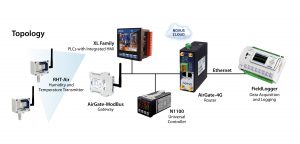Data cache memory system prevents data loss
Each application project has specific deployment requirements. For many applications, it is essential that the logs have no gaps in the history. Losing data due to a power outage or communication interruption can be devastating for companies.
To meet this demand, NOVUS has developed a system to overcome the problems caused by communication failures on different physical media: The data cache memory system. It consists of temporarily storing data that has been selected to be published but has not yet been uploaded to NOVUS Cloud, making it possible to publish this mass of data later.
For AirGate-4G, for example, if the device is unable to send the data selected to be published on NOVUS Cloud at the time, it will be stored in memory until it is published on the cloud. Any data that has already been sent will be removed from the memory, so that space is available in case it needs to be stored for a longer period (temporarily stored data cannot be collected).
AirGate-4G accepts two types of data cache memory: Temporary and permanent.
RAM (or temporary memory) can store up to 5000 pieces of data. However, this data is lost after the device is rebooted. Flash (or permanent) memory, on the other hand, stores 5000 pieces of data and keeps them even after the device has been reset.
Therefore, even if the product loses access to the Internet for any reason, it will store the data with the timestamp of the moment the data was acquired and, as soon as the connection is re-established, the stored data will be sent to the cloud, generating a gap-free history. If the disconnected time is longer than the available data cache memory, the oldest data will be overwritten (circular memory system).

Keep reading:
Data logging: How many acquisitions can be stored in a data logger?
FieldLogger was not NOVUS first data logger
Data logging in sanitation: How to have greater control and avoid excessive losses

















